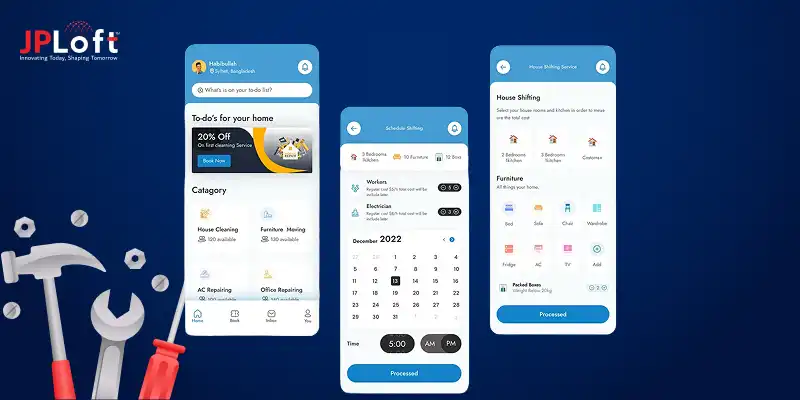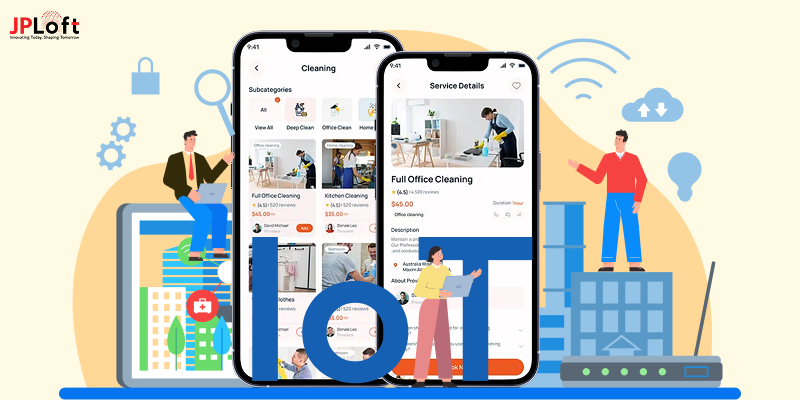Key Takeaways:
To build an Angi clone, start with market validation and a clear scope to meet user demand effectively.
Here, you can include AI-driven features like predictive pricing, smart service matching, and chatbots to improve user trust, satisfaction, and repeat bookings.
The security landscape to include here is compliance, secure payments, and verified professionals, creating a trustworthy marketplace that protects both homeowners and service providers.
Flexible monetization models to include here are commissions, subscriptions, and lead generation to ensure recurring revenue and long-term growth.
A scalable tech stack with multi-platform reach future-proofs your handyman app against evolving customer expectations.
Partner with JPLoft, a leading development company, to turn your vision into a secure, feature-rich, and profitable platform.
“Opportunities don’t happen, you create them.” - Chris Grosser
This quote by Chris Grosser perfectly reflects the booming digital service economy, where platforms like Angi have transformed how people access home improvement and handyman services.
For entrepreneurs and investors, the rising demand in this sector presents a remarkable chance to replicate and even innovate beyond Angi’s success. With the global handyman market projected to reach $2,340.4 million by 2035, the potential is too significant to ignore.
Now, the big question is: how to build an app like Angi?
You can build an app like Angi by following the process that begins with conducting market research, defining the scope, integrating over 15 essential features, ensuring compliance, and leveraging AI-driven solutions to enhance user trust and engagement.
This blog is tailored for entrepreneurs and investors aiming to build a scalable, feature-rich handyman marketplace app. Let’s break down every crucial step to turn this opportunity into a profitable reality.
An Overview of Angi: Handyman Services Marketplace
The Angi app has two important versions, one for homeowners and one for professionals.
Angi app, which is for homeowners, is all about finding and hiring professionals for different home projects. Whereas another version is for the professionals who wish to connect with the customers and find a platform for building a connection with them.
Additionally, for the homeowners, it provides a wide range of services, from minor repairs to major renovations. Furthermore, it even helps to facilitate the complete hiring procedure through matching the users with the vetted professionals, providing the tools for managing the communication and projects.
Let’s bring in some handyman app market stats to understand the complete marketplace well.
-
The global handyman market size is valued at USD 342 million in 2022, and is further expected to grow at a CAGR of 13.4% during the forecast period of 2023 to 2032..
-
Furthermore, in 2025, the global handyman service market is estimated to be valued at approximately USD 530.5 million. And by 2035, this market is further projected to grow to around USD 2340.4 million, which reflects a CAGR of 16%.
-
Additionally, when it comes to the Angi app, the current number of downloads here is 5M+ over the Play Store, which represents a significant number of people who are using the app.
-
When you look at the authority score of the app, along with its millions of downloads and organic traffic, the US is the region where people are finding Angi the most useful app. As per Semrush, the app has organic traffic of 3.5 million, which represents the user engagement rate of the app.
Additionally, the app follows and adopts recent handyman app trends that help the business to remain competitive.
When it comes to building an app like Angi, you should know what makes it so popular.
Hence, let’s find out in the following section.
Why is the Angi Handyman App So Popular?
The popularity of an app like Angi totally falls under different determinants, such as its features, the app’s efficiency to serve the target users, and its overall performance in the competitive market.
Thus, before answering “how to build an app like Angi?” you should proceed to learn what makes it so popular to build.
Let’s evaluate them all in detail, below.
1. Extensive Service Network
Angi has created a vast network of pre-screened, licensed professionals that span several categories of home services and serve as the one-stop shop for homeowners.
The background check and customer review validation vetting process of the app instills confidence that others cannot equal.
For founders hoping to build an app like Angi, this holistic method of professional onboarding and quality control is the gold standard that makes it stand out among competitors.
2. Simple, Intuitive Interface
The Angi platform boasts a user-friendly interface that streamlines the process of discovery, scheduling, and management of home service appointments with intelligent matching algorithms.
Customers can simply explain their work, get quotes from several professionals, and compare professionals in terms of ratings, prices, and availability within minutes.
The advanced matching algorithm of the app connects homeowners with the appropriate professionals as per their unique requirements is what makes it popular.
3. Multiple Quote System and Transparent Pricing
One of the most significant differentiators of Angi is its open pricing system that enables homeowners to get multiple estimates from various professionals for comparison. Develop an app like Urban Company that follows this model, and you can effectively resolve multiple user requirements across services.
Its competitive bidding platform helps ensure price fairness while providing users with absolute clarity into service prices before commitment.
The standardization capability of the platform in terms of pricing across different services has changed the way homeowners consider home improvement jobs, becoming a prime reason for its popularity.
4. Combined Payment and Management Features
Angi provides smooth payment processing, project monitoring, and communications features in one platform without the use of multiple apps or separate coordination.
The combined platform features include milestone payments, project schedules, and direct messaging between homeowners and professionals.
For Angi app-like projects, this complete set of features illustrates the significance of developing an all-in-one service instead of fragmented services. The platform's capacity for handling everything from the first booking to the last payment generates a better user experience, which encourages repeat business.
5. Powerful Review System and Quality Assurance
The app's strong review and rating system, along with Angi's guarantee policies, ensures accountability and quality assurance that instill long-term user confidence.
Real customer reviews, picture proof of finished work, and excellent customer support ensure a trustworthy ecosystem.
The commitment of the platform to follow-up surveys and conflict resolution has established industry standards for customer satisfaction, enhancing its popularity in the marketplace.
6. Multi-Platform Reach and Local Market Orientation
Angi's success is rooted in its presence on web, iOS, and Android platforms, making it accessible to customers irrespective of their device of choice or location.
The app's established local market presence, city-specific professional networks, and regional service knowledge provide a customized experience for every geographic region.
The capability of the platform to deliver uniform service in various markets while conforming to local specifications has been instrumental in its ubiquitous usage, which makes the app so popular.
These were some of the crucial determinants to consider when it comes to evaluating the popularity of an app like Angi.
Now, one of the questions that you might face is “Why build an app like Angi?” Let’s find it out in the section below.
Reasons to Build an App like Angi in 2025
When you proceed to start an online handyman business, one of the crucial points is identifying the reasons for creating it.
The primary reasons can be huge market expansion, an underserved niche market, technology advances, and a huge subscription economy.
Whether it's about a business or building the best Handyman apps, it's essential to look for important reasons. Let’s cover them all below.
1] Huge Market Expansion
Based on the current market study, conducted by the CMI market research team, the market size is expected to reach a valuation of USD 1,579.14 million by 2033.
Post-pandemic behavior indicates that customers are seriously investing in home improvement, resulting in long-term demand for trustworthy service platforms.
When you develop an app like Angi in 2025, you're tapping into a market that has remained resilient and keeps growing at a fast rate.
2] Technology Advances Improve User Experiences
Emerging technologies such as AI-based matching algorithms, AR visualization software, and IoT integration are changing the nature of how home service apps function and add value to users.
Sophisticated features such as real-time project monitoring, intelligent scheduling, and predictive maintenance suggestions weren't possible a few years ago but are now expected norms.
Entrepreneurs who develop an app like Angi today can use these advanced technologies to develop more effective, user-centric platforms than previous service app generations.
3] Underserved Niche Markets
Despite Angi's success, numerous underserved markets and specialized niches remain untapped, particularly in rural areas, specific demographic segments, and specialized service categories like eco-friendly contractors or elderly-focused services.
Regional markets often lack comprehensive platforms that understand local regulations, pricing structures, and cultural preferences, creating opportunities for targeted solutions.
Verticals like luxury home services, emergency repair networks, or commercial property maintenance are high-value niches. Thus, if you make an app like Angi in 2025, it can provide you with a quick economic gain in the market.
4] Subscription Economy
The transition to subscription-based services and membership schemes in 2025 provides the prospect for more controlled, scalable revenue streams than legacy transactional platforms.
Consumers now want subscription services with priority booking, reduced rates, and package maintenance bundles, disengaging from single-service transactions.
When you create an app like Angi with subscriptions, you can forge deeper customer relations and greater lifetime values than legacy marketplace schemes.
5] Professional Licensing Digitalization
The recent regulatory moves towards digital licensing verification, insurance tracking, and compliance monitoring open the door for platforms capable of smoothly incorporating these requirements into their business.
Government regulations to digitalize professional certifications and simplify the permitting processes benefit platforms with the ability to automate compliance and minimize administrative hassles for professionals and customers alike.
The chance to make an app like Angi will help you resolve these regulations and achieve a significant goal by reaching the target audiences.
Now, as you are ready to build an app like Angi, let’s figure out the crucial features to include in it. Let’s evaluate them all below.
Features to Include in an App like Angi
Features are the blood of an app; learning about them will resolve your 1/4th of issues.
Let’s evaluate the diversified Handyman app features below.
|
User-Centric Features |
Advanced Features |
Admin Features |
|
Easy registration & login |
AI-based handyman matching |
Admin dashboard |
|
Service search & filters |
AR-based project previews |
Service provider management |
|
Booking & scheduling |
Predictive pricing |
User activity monitoring |
|
Secure payments |
Loyalty & referral programs |
Dispute resolution system |
|
Reviews & ratings |
Smart recommendations |
Analytics & reporting |
|
In-app chat & notifications |
Voice-enabled service booking |
Promotions & offers management |
Now, let’s move ahead with the complete development process to create an app like Angi in the following section.
How to Develop an App like Angi in 2025?
You can create an app like Angi by identifying the current market, evaluating the features, selecting an efficient technology stack, conducting testing, and then launching the app in the market.
Well, the process of handyman app development is impacted by various determinants such as the skills of the developers, the location of the developers, and the complexity or clarity of your business idea.
Let’s learn in detail about how to develop an app like Angi, below.
Step 1: Validate the Opportunity & Define Scope
One of the prime steps is to identify the opportunity in the market and define the wide scope. It is all about clarifying the purpose of creating the app and defining your target audience.
A] Market & Audience Fit
Define your Ideal Customer Profiles (homeowners, landlords, property managers) and top jobs (plumbing, electrical, HVAC). Estimate demand by city to prevent cold-start gaps.
B] Competitive Teardown
Chart Angi, Thumbtack, TaskRabbit, and local competition. Observe their onboarding, pricing, take rate, strengths/weaknesses, and where you can excel (speed, trust, pricing).
C] Value Proposition & Positioning
Choose your wedge: quicker quotes, vetted pros, flat fees, or a guarantee. Develop messaging that addresses the user's #1 fear—"Will this pro show up and get it done?"
D] Success Metrics & Budget
You need to develop a complete budget, evaluate the prospective success metrics, and define anchor KPIs: request-to-book rate, fill rate, job time completion, and NPS. Align budget and timeline with a milestone plan for MVP → Beta → GA.
Step 2: Trust, Safety & Compliance Foundations
Now, it's time to evaluate the handyman compliance practices. Here, you should evaluate the overall handyman app security practices and safety tools for protecting your app from fraud and misleading practices.
A] Provider Verification (KYC)
Gather government ID, licenses, insurance, and background checks. KYC = "Know Your Customer," identity verification and fraud prevention standard.
B] Payments, Escrow & Disputes
Use escrow to hold pay in escrow until completion of the job. Establish a proper dispute procedure with rules of evidence, SLAs (service level agreements), and refunds for partial work done.
C] Data Privacy & Policies
Be GDPR/CCPA compliant: consent, data minimization, retention, and user data export/delete flows. Post clear terms, privacy policy, and safety guidelines.
D] Fraud Prevention & Reviews Integrity
Apply anomaly detection to identify fake jobs/reviews. Enforce verified bookings for reviews, rate-limit feedback, and include audit logs for moderation.
Step 3: Nail the Core Product & Architecture
Now, it's time to create a mobile app wireframe for your Angi-like app. This is all about developing a complete blueprint for your app.
A] Core User Flows
You should define the user persona. Search → shortlist → request/instant book → chat → pay → review. Minimize steps, make them predictable, and mobile-first. It will help you to define key feature requirements and core functionalities. You can go with creating a mobile app prototyping that comprises interactive, non-functional digital models for stimulating an app’s design.
B] Provider Supply Flows
Here, you need to define the structure of the business and your app how the supply channel will flow, to enhance the user experience. Easy onboarding, service catalog, service areas, pricing, and availability calendar. Bulk import facilitates agencies' fast onboarding.
C] Pricing & Job Types
In this aspect, you need to define the overall pricing factor for your app. Here, you can create a tiered job categorization system for the job finders and for the homeowners. Support fixed price, time & materials, and bid-based quotes. Allow users to upload photos/videos to refine estimates.
D] System Architecture
Begin with a modular monolith (fewer moving parts). Design domains: Identity, Catalog, Search, Booking, Payments, Reviews, Notifications. This will all help you to build the complete architecture for your app.
Step 4: Considerate UX/UI for Both Parties
You should initiate with the mobile app design parameter. This is all about crafting the design algorithms and selecting the color, theme, as well as UI/UX for your app. Hence, let’s learn about it in detail below.
A] Information Architecture
Simple categories (Plumbing → Leak Repair), locality filters, and trust badges (licensed, insured, background-checked).
B] Booking UX
The handyman app design should comprise identifying and implementing tools for designing your Angi-like app. Two ways: "Instant Book" for straightforward tasks; "Get Quotes" for complicated work. Highlight ETA windows and price transparency from the very beginning.
C] Communication & Transparency
In-app chat with photo/video, read receipts, and appointment reminders. Reveal arrival countdown and live status updates.
D] Accessibility & Localization
WCAG-compliant colors/contrast, large tap targets, and clear language. Plan for multi-language and right-to-left layouts in advance.
Step 5: Select a Modern Tech Stack
It's significant to select a modern technology stack for your app in this step. The mobile app tech stack should comprise identifying the language, database, and technical aspects. Let’s figure it out below.
A] Client Apps
Mobile: Flutter or React Native for cross-platform performance. Web portal for providers/admin in React/Next.js.
B] Backend & Data
Selecting the suitable handyman app tech stack is based on the type of languages you select, such as Node.js (NestJS) or Python (Django/FastAPI), PostgreSQL for transactional database, Redis for caching layer, and a queue (RabbitMQ/SQS) for async jobs.
C] Integrations
The handyman app API integrations should be based on the purpose of your app. Here, the integrations can include maps (Google/Mapbox), payments (Stripe/Adyen), notifications (APNs/FCM + email/SMS), Search (Elasticsearch/OpenSearch), analytics (GA4 + product analytics).
D] DevOps & Security
CI/CD pipelines, infrastructure as code (Terraform), logs/metrics/traces for observability, and a SIEM (Security Information & Event Management) to identify threats.
Step 6: Create the MVP (90/10 Rule)
Now, it's time to build an MVP (Minimal Viable Product), which is all about creating a version of the app with minimum features to launch it for the early adopters, then you can edit the app and enhance its overall functionalities.
A] Must-Have Features
To make an Angi clone, you should consider must-have features such as sign-up for users, onboarding providers, search & filters, request/booking, chat, payments/escrow, ratings/reviews, and notifications.
B] Provider Operations
Availability calendar, job accept/reject, route planning, and basic earnings dashboard. Minimize paperwork.
C] Admin Backoffice
User/pro moderation, job escalation, refunds, coupons, and CMS for FAQs/policies. Include role-based access control early on.
D] Content & SEO Basics
Service pages per city/category, structured data, and review snippets. Create a lightweight knowledge base for common jobs.
Step 7: Test for Quality, Security & Reliability
Now, it's time to proceed with the mobile app testing landscape. This is the area where you need to conduct vast testing based on performance testing, security testing, compliance evaluation, and functional testing.
A] Functional & Edge Cases
Here, you should define the functional and edge cases. Test flows end-to-end: booking changes, no-shows, partial refunds, and multi-day jobs. Support photo/video uploads, as well as large messages.
B] Performance & Scale
Load test search and booking spikes (evenings/weekends). Make use of database indexing and caching; benchmark P95/P99 latencies.
C] Security Reviews
To create an Angi clone, it's essential to have OWASP Top 10 checks, dependency scanning, secrets management, and periodic penetration testing. Implement least-privilege access
D] Compliance & Documentation
DPAs with vendors, incident response runbooks, and backups/restore drills. Keep release notes and changelogs concise. Compliance testing will help you to comply with the industry norms and app launch regulations. This will help you to sustain in the devastating market in the long run.
Step 8: Launch Plan & Early Growth
Ready to launch your Angi-like app? Well, it's time to plan your launch. You should publish the app on the Play Store or launch the app on the App Store, based on your target audience and the purpose of your app.
A] Beta & Phased Rollout
Roll out in 1–2 cities. Hire a curated group of experts, seed early reviews, and operate concierge support to learn quickly.
B] Supply Acquisition
Zero-fee trial, immediate payouts, and lead credits for early experts. Provide a basic "bring your clients" importer to lower friction.
C] Demand Generation
Local SEO, Google Local Services Ads, homeowner partnerships, and referral bonuses. Emphasize price transparency and verified pros.
D] Support & SLAs
Speedy, human support in beta (chat + phone). Monitor first-response and resolution times; loop back with post-job surveys.
Step 9: Iterate, Monetize & Scale
Now, it's time to identify the metrics, conduct effective experiments, and determine whether your app can reach the target audience or requires additional features or elements to enhance its complete functionality.
A] Metrics & Experiments
Instrument activation, fill rate, time-to-match, repeat bookings, and LTV/CAC. Conduct controlled A/B tests on pricing and UX.
B] Monetization Models
Commission per project, lead fees, provider subscriptions, and premium placement. Pilot "Angi-style" fixed-price packages for routine jobs. Here, you should evaluate the mobile app monetization models suitable for building your app, like Angi.
C] Advanced Features
AI matching (rank by skills, distance, reliability), dynamic ETAs, bundled jobs, and maintenance plans. Add warranties for trust.
D] Geographic Expansion
Playbook per city: supply first, then demand. Localize categories, pricing, and support hours; automate compliance checks.
Step 10: Conduct App Maintenance Procedure
Now it's time to proceed with the handyman app maintenance process. It is a continuous process and comprises user management, real-time tracking, job execution, along technical maintenance.
A] Regular Bug Fixes & Updates
Continuously monitor for bugs and glitches that impact user experience. Roll out timely updates to keep the app stable and compatible with new OS versions.
B] Security Patches & Compliance
Apply critical security patches to protect user data and payments. Ensure compliance with evolving data privacy laws like GDPR and CCPA.
C] Performance Monitoring & Optimization
Track app performance metrics such as load times, crash rates, and server uptime. Optimize code and infrastructure to deliver smooth user experiences.
D] Feature Enhancements & Scalability
Gather user feedback to refine existing features and introduce new ones. Scale infrastructure to handle more users, services, and geographic expansion.
Till now, we have learned about the concept of the Angi app, its related features, the app’s popularity, reasons to build it, and steps for creating it.
Now, if your question still exists related to “ how to create an app like Angi?”
Then, you can opt for advanced practices and technologies such as artificial intelligence to build it. However, to build an AI app, you will require a team of experts.
Now, let’s proceed with learning about the role of AI in creating an app like Angi in the following section.
Can AI Help Create an App Like Angi? How!
Artificial intelligence is one of the important aspects when you consider building a mobile app in the current era. It is a crucial phenomenon that can provide you with assistance at every stage, from idea generation and design to automated testing and maintenance procedures.
Let’s find out the role of AI in creating an app like Angi, below.
1. AI-Driven Service Matching
With AI, it becomes easy to instantly match homeowners with the most competent and relevant service providers. Through skills analysis, availability, location, and previous work performance, AI achieves quicker and more intelligent matching.
For anyone who intends to develop an app like Angi, this feature is essential in establishing user trust and increasing conversion rates.
2. Predictive Pricing & Cost Estimation
AI in handyman apps is effective in identifying the estimated cost for developing an app like Angi. One of the greatest home service challenges is ambiguous pricing. AI can scan past job data and industry trends to offer real-time cost estimates upfront before scheduling.
Transparency is a requirement if you are to build an Angi clone since it enhances trust, minimizes disputes, and boosts customer satisfaction.
3. Fraud Detection & Trust Building
Spam bookings, fake reviews, and scam providers can harm credibility. AI can identify patterns in suspicious behavior, suppress spam accounts, and authenticate legitimate reviews.
In the Angi app, a similar app development, this trust layer makes the user feel secure when they hire experts, which provides a competitive advantage to your app. You can even go for building an AI agent that will be useful in dealing with early fraud detection and constructing user trust.
4. Smart Customer Support (Chatbots)
AI-powered chatbots can be used as 24/7 helpers, processing FAQs, making booking modifications, and resolving disputes. They can even upsell or suggest the appropriate service depending on the user's inquiry.
If you need to develop an app similar to Angi, smart AI chatbots minimize support expense while providing a smooth end-user experience. An experienced and leading AI app development service can help you add effective AI technologies for customer support.
5. Customized User Experience
AI facilitates hyper-personalization through recommending services based on user activity, past bookings, and seasonal demand (e.g., HVAC maintenance during summer).
This engages your app and makes it stickier. Personalization in the Angi app, like development, enhances repeat use and allows your platform to stand out from generic alternatives.
6. Predictive Maintenance & Resource Optimization
AI can predict demand peaks, like plumbing during winter or electrical problems when it storms, and assign service providers accordingly.
In this way, users receive services promptly without prolonged waiting hours. If you wish to develop an Angi clone, AI-powered resource optimization provides for smoother operations and improved scalability.
After learning about the role of AI in building an app like Angi, let’s evaluate the complete mobile app development cost mechanism in the following section.
How Much Does It Cost to Develop an App Like Angi?
On average, the cost to build an app like Angi can vary from $30,000 to $200,000. However, this cost is further impacted by diversified factors such as the complexity of factors, complicated app design, tech stack, testing, and much more.
Let’s evaluate the complete factors impacting the total cost to develop a handyman app in the table below.
|
Cost Factor |
Impact on Cost |
Estimated Cost Impact |
|
App Complexity |
Basic vs. advanced workflows (simple booking vs. AI-based matching) |
$5,000- $30,000 |
|
Features & Functionality |
Core features vs. advanced add-ons (chat, reviews, AR/VR, AI) |
$10,000- $50,000 |
|
Platform Choice |
Single platform (iOS/Android) vs. cross-platform development |
$8,000- $25,000 |
|
Design & User Experience |
Basic UI vs. custom, modern, and user-friendly designs |
$5,000- $20,000 |
|
Tech Stack & Integrations |
Simple APIs vs. complex integrations like payments, maps, and AI tools |
$7,000- $30,000 |
|
Development Team Location |
Teams in North America cost more than Asia or Eastern Europe |
$15,000- $50,000 (depending on region) |
|
Testing & Quality Assurance |
More rigorous QA increases reliability, but also time and cost |
$5,000- $15,000 |
|
Post-Launch Maintenance |
Ongoing bug fixes, updates, and security patches add recurring costs |
$3,000- $10,000 annually |
After learning about the cost, let’s consider the overall monetization strategies in the section below.
What are the Monetization Strategies to Include in an App like Angi?
Including the monetization strategies can not only help you to make money via the app, but it will also help you to identify prospects to enhance your app’s presence in the market and to make your app better among competitors.
Let’s discuss all the core handyman app monetization strategies below.
1. Commission-Based Model
Impose a percentage charge on all successful transactions between the customer and service provider. This model provides steady revenue that increases with an increase in the number of bookings.
It's versatile, as you can charge varying commission rates for various service categories, striking a balance between affordability and profitability.
2. Subscription Plans for Service Providers
Provide premium membership levels for professionals where they pay annually or monthly to have access to more leads, improved tools, or increased visibility.
This strategy is particularly effective if you intend to create an app like Angi, as it generates consistent recurring revenue. It also fosters loyalty, because providers who pay for subscriptions tend to remain active on the platform.
3. Lead Generation Fees
Rather than billing by the completed job, professionals pay for access to vetted customer leads. This assures revenue upfront and minimizes dependence on the success of the service.
It also enables professionals to scale at their own rates, as they can buy only the quantity of leads they wish to work on.
4. In-App Advertising & Featured Listings
Allow service providers to pay for priority placement in search results or highlighted features. It is also possible to include ads from complementary businesses, which is a popular monetization method when business owners develop an app such as Angi.
The model puts providers in a more visible position while adding another revenue stream to your app beyond bookings.
5. Value-Added Services
Offer add-ons like extended warranties, insurance bundles, or premium customer support. These not only foster trust but also drive up the average revenue per transaction.
Value-added services distinguish your app from other apps and create long-term customer trust in the platform.
Partner with JPLoft and Build Your Own App
If you’re planning to launch your own handyman or service marketplace app, choosing the right technology partner is the first step toward success.
JPLoft is a trusted name in custom mobile solutions, helping businesses create powerful, user-friendly, and scalable applications tailored to their vision.
From idea validation and design to coding, testing, and deployment, their team ensures that every stage of development aligns with your business goals.
As a leading handyman app development company, JPLoft specializes in building apps like Angi, Thumbtack, and TaskRabbit, but with unique features customized for your target audience.
Whether you want a simple MVP or a fully featured, AI-driven marketplace, they provide cost-effective and reliable solutions. Their focus on user experience, secure integrations, and post-launch support makes them an ideal partner for entrepreneurs looking to dominate the growing home services industry.
Conclusion
Building an app like Angi is a structured process that moves through ten essential steps, starting with market validation and compliance, followed by defining architecture, designing an intuitive UX, selecting the tech stack, creating the MVP, testing, launching, scaling, and ongoing maintenance.
Alongside this journey, the app integrates more than 15 core features across user, advanced, and admin sides, including booking, secure payments, reviews, AI matching, AR previews, predictive pricing, analytics, and more.
By combining these steps with a strong feature set, entrepreneurs can develop a reliable, scalable, and competitive handyman marketplace tailored for long-term growth.
FAQs
You can develop an Angi-like app by following 10 structured steps: market research, compliance, system architecture, UX/UI, tech stack selection, MVP creation, testing, launch, scaling, and maintenance. Each step ensures the app is user-friendly, secure, and scalable for long-term success.
Some features are essential, categorized into user (booking, payments, reviews), advanced (AI matching, AR previews, predictive pricing), and admin (dashboard, dispute resolution, analytics). These features ensure smooth operations and a trustworthy experience for both homeowners and professionals.
The cost ranges from $30,000 to $200,000 depending on app complexity, features, design, tech stack, and development team location. Ongoing maintenance may add $3,000 to $10,000 annually.
Angi is popular due to its vast professional network, user-friendly interface, transparent pricing, secure payments, review system, and AI-driven matching that makes finding services easy and trustworthy.
AI adds smarter service matching, predictive pricing, fraud detection, chatbots, and personalized recommendations. This boosts user trust, satisfaction, and repeat usage.
Effective models include commissions on completed jobs, provider subscriptions, lead generation fees, featured listings, in-app advertising, and value-added services like warranties or premium support.













Share this blog